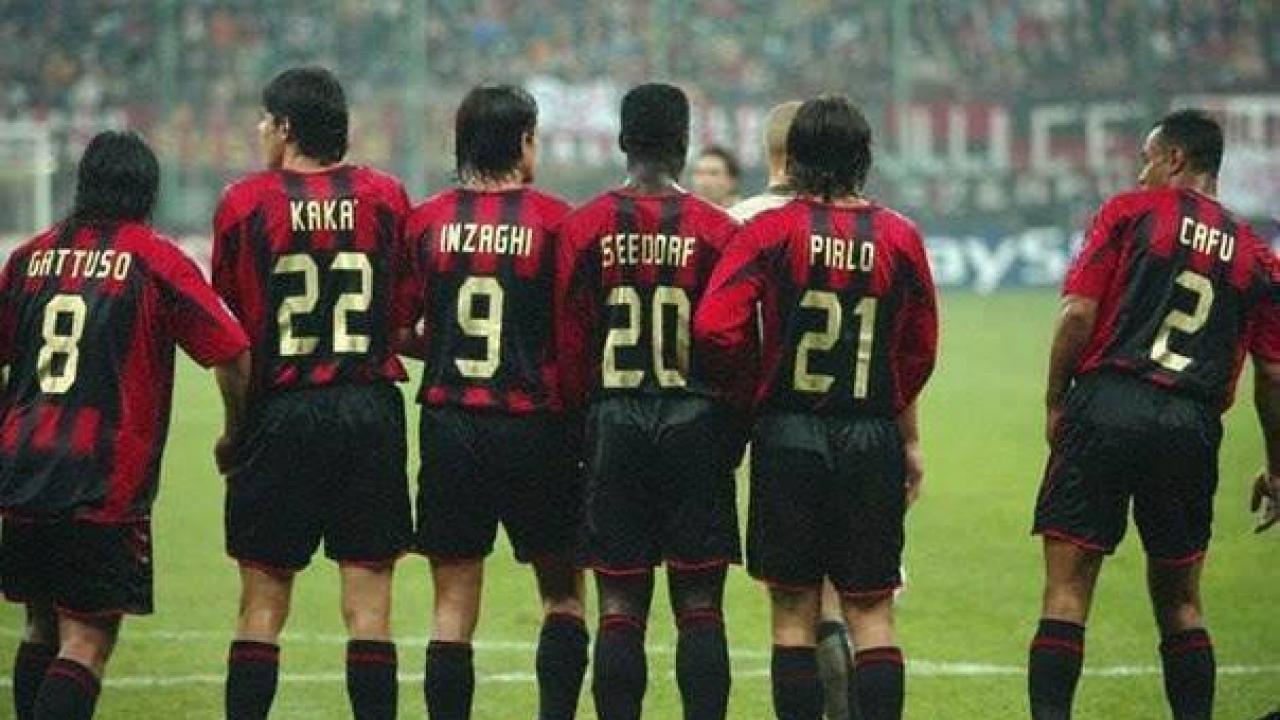AC Milan Renaissance. Tommy Vercetti is a cool guy. He owns the entire Vice City. He can beat an old man to a pulp, and no one will bat an eyelid. If the police are stupid enough to object, the man could conjure a freaking military tank from thin air and blow everything to smithereens. Other than a hilarious inability to swim, Tommy has everything. He drives Lamborghinis, has a lot of money and is the ultimate ladies’ man.
After a boring day at school, I couldn’t wait to become this arrogant dude who wielded unlimited levels of power.
My childhood summed up in 95 words.
A Special Time. Such A Special Time.
*
“You guys will never get it; we had so much fun. The things which you guys are missing out on (a sarcastic pffff follows). Our childhood was the best ever.”
My brother rambles on, drooling in a pool of nostalgia.
Once he starts, he never stops.
The period from the early 90s to the mid-2000s can be considered as a bridge between “What Is” and “What Used To Be”. It was nothing short of a “Technological Revolution”. Without the modern computer, Bill Gates could have been a random guy hanging out in McDonald’s like the rest of us. Super Mario became a worldwide sensation. Tim Berners-Lee created the World Wide Web, which made the Internet the global phenomenon it is today, and somewhere in New York, a teenage Mark Zuckerberg was preparing himself to break the Internet. Mobile Phones were actually used to call back then. The most popular mobile phones of that era were the ones of the Finnish.
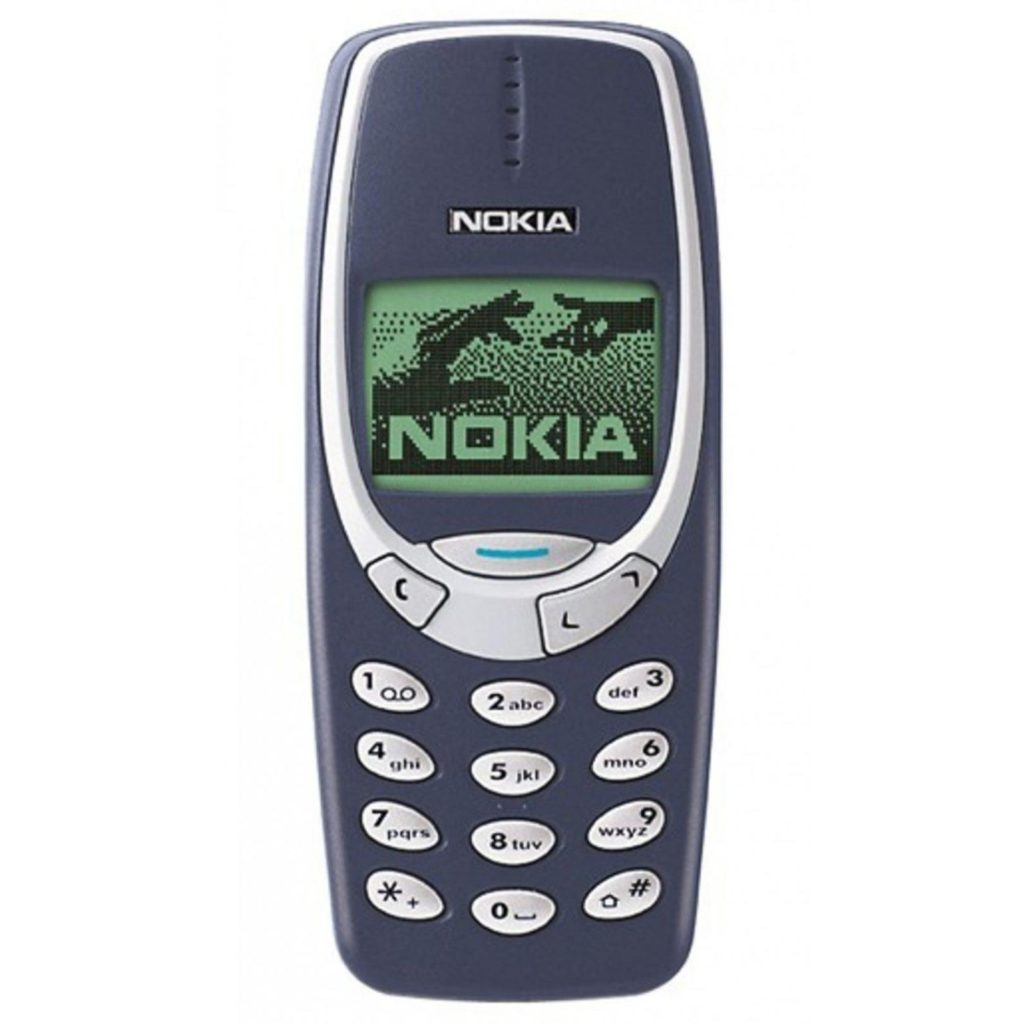
The old Nokia was iconic. It used to be a status symbol. The green screen, Snake Game and the fact that it could survive a fall from the top of a building will be discussed for generations to come. Samsung? Nah. iPhone? Nah. The Nokia 3310 is the most loved phone ever.
Nokia could have built a dynasty. But it was not to be.
*
May 7 2011
This is a day that no fan of AC Milan will forget. Milan stood their ground against a resolute Roma to claim their first Scudetto in seven years, breaking the dominance neighbour and fiercest rival Inter Milan had over the Italian Serie A.
No one could have predicted back then that it would be the last Scudetto the Rossoneri would claim before going downhill the next few years until they became a shadow of their former selves.
*
Associazione Calcio Milan used to be one of the biggest football clubs in the world during its heyday. Among the Italian clubs, Milan has enjoyed the most success in Europe. The club has won seven European Cups, second to only Real Madrid, with 13 to their name. It saddens me that the stature of a Milan club has declined drastically in the past decade. From being virtually the table-toppers every alternate year, the club has been an average mid-table team for the last ten years!
*
In the past, Serie A was considered by many to be the best league in Europe. The title race was often a three-way battle between Milan, Inter and the “Old Lady of Turin” Juventus. But in the last decade, it was reduced to a scramble for the European spots as Juventus kept on winning the league, often by staggering margins. From 2012 to 2020, The Old Lady won an incredible nine league titles in a row. The Premier League has taken English football to the next level. Barcelona and Real Madrid have made Spanish Football the global force it is today. Amidst all this, Italian football has somewhat become an afterthought.
*
During the 50s, Milan gained global popularity and waded its way to the top of Italian football. They won the Scudetto in 1951 for the first time since 1907, and also, the first of Milan’s two legendary trios were part of this team. The “Gre-No-Li” was an All-Swedish trio formed by “The Professor” Gunnar Gren, “Il Pompierone” Gunnar Nordahl and “Il Barone” Nils Liedholm. Of these three, Nordahl was the most lethal, scoring goals for fun while Gren and Liedholm slotted behind him.
Milan owes a great deal to these brilliant Swedes for the success they had during those days. The team also had probably the best Italian defender of the generation, “Cesarone” Cesare Maldini, leading from the back.
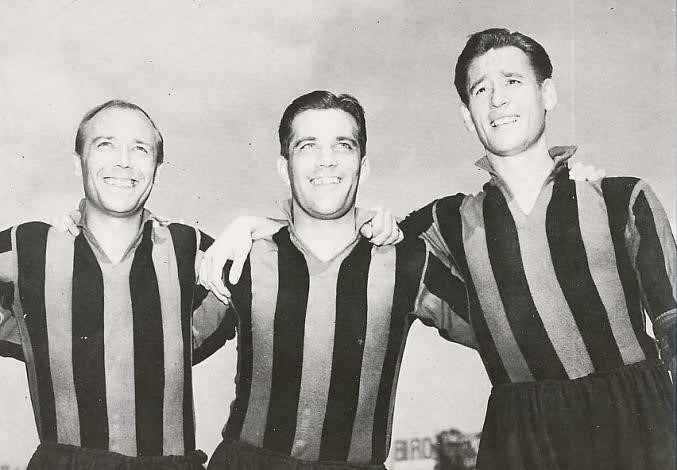
During this period, the most famous win by Milan was the 7-1 thumping of Juventus in 1950, with all three of the “Gre-No-Li” appearing on the score sheet with Nordahl scoring a hat trick. Milan clinched over four Serie A titles in the decade, emerging victorious in 1951, 1955, 1957 and 1959. It was the start of a beautiful love story.
*
The 50s was a superb period for the Rossoneri. But one accolade constantly evaded them—the European Cup. Since the inaugural season in 1955, Real Madrid had taken the tournament by storm, winning five European Cups in succession, a record intact to date. Milan had the trophy within touching distance in 1958, but Madrid, led by the mercurial Alfredo Di Stefano, stood firmly in the way.
This changed in the 60s. Then, legendary manager Nereo Rocco was at the helm. Regarded as one of the Greatest of All Time, he was an astute tactician and is remembered to this day for developing and mastering the Catenaccio, a style of football that mainly focused on the defensive aspects of the game. The art of defending is the bread and butter of Italian Football, something which has since become ingrained in its DNA. You think Football Italia; you think Maldini. You think Baresi. You think Cannavaro. The Catenaccio and its various variations have been interpreted and used by many teams and managers in the following decades, with varying success.
Milan also enjoyed the services of Brazilian forward José “Mazola” Altafini at this time. He led them from the front and has scored over 150 times for the club. The legendary Brazilian was nicknamed “Mazola” due to his resemblance with Italian midfielder Valentino Mazzola. Another player who made a name for himself during this period was Gianni Rivera, an essential cog in the team’s midfield.
In the 1963 season, Rocco’s Milan won their maiden European Cup, defeating Benfica 2-1 in the finals, with Altafini scoring a brace. Despite the success in Europe, Milan brought in fewer domestic laurels in comparison with the previous years. This is mainly because of the rise of arch-rivals Internazionale. They won the European Cup again in 1969, six years after their last triumph. Just like Milan, Inter also won two European Cups in that period, doing so in succession. Milan failed to conquer Europe again for over 20 long years, their third triumph being in 1989.
*
Milan endured a torrid time in the 70s. They managed to win just a single league title in the decade, a far cry from their previous dominant selves. “Gre-No-Li” star Nils Liedholm had returned to coach the side during this period.
Also, “Piscinin” Franco Baresi, perhaps the greatest defender in the club’s history and most definitely one of the greatest defenders the game has ever witnessed, made his debut for the Rossoneri in the late 70s. For nearly 20 years, Baresi was an unquestionable presence in both the club and the national side.
The late 70s and early 80s were when Milan hit rock bottom. The club got relegated to Serie B in 1980 after being caught in the Totonero match-fixing scandal along with Lazio, Napoli, Perugia and many others, among whom Milan and Lazio were relegated.
Milan languished in Serie B for two seasons, and even after getting promoted, they were not the same dominant force they were before. For long periods, until the Silvio Berlusconi revolution kicked in, the club was in constant decline.
*
Undoubtedly, Cesare Maldini was one of the greatest defenders to ever play for Milan. He captained them during their maiden European Cup win and was part of the 50s and 60s great teams. In football, the second or third-generation players often do not match their predecessors. On the other hand, Paolo Maldini matched Cesare Maldini and most definitely outshone him. The younger Maldini debuted in 1985 when Milan was undergoing a slow resurgence after the dark days of the early 80s. For the next 20-odd years, like Baresi, he would be a titanic figure in Milan’s spine.
On March 24 1986, Italian media tycoon Silvio Berlusconi was named the 21st president of Milan. He owned the club from 1986 to 2017. Under his ownership, Milan was the cream of the crop in European Football for large periods. Milan meant business in the next few years, bringing in the likes of Roberto Donadoni and Dario Bonetti. Slowly but steadily, the club progressed and ushered in a new era that commenced with the arrival of “The Prophet of Fusignano” Arrigo Sacchi.
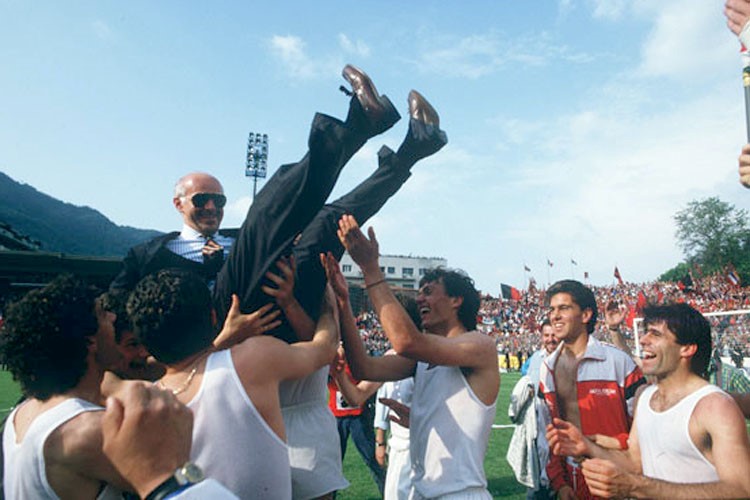
Arrigo Sacchi is nothing short of a genius. He has a credible claim to be considered one of the greatest minds in football. He is a master tactician. The idea of zonal or zone-to-zone marking was pivotal to the football Milan used to play under Sacchi. Another feature of the football Milan played was the constant pressing off the ball.
They hit their peak in the late 80s. They were a complete team with a rock-solid defence, a dominant midfield and a lethal attack. The arrival of the Dutch duo of Marco Van Basten and Ruud Gullit sent shockwaves across Italian Football. Later, they were joined by their Dutch partner in crime, Frank Rijkaard, thereby completing one of the most destructive trios in the history of world football.
Sacchi played a 4-4-2 formation, with Franco Baresi, Paulo Maldini and Alessandro Costacurta forming an impenetrable defensive line. Up top, Van Basten and Gullit tormented the opposition, with Angelo Colombo and Roberto Donadoni creating magic from the wings and Rijkaard slotting behind in midfield along with one Carlo Ancelotti. What a team!
Milan endured a slow start under Sacchi but sprang to life during the latter half of the campaign. The club won their 11th overall and first Scudetto in almost a decade. Sacchi masterminded the return of the European Cup to San Siro after twenty long years, winning the competition in 1989 and once again in 1990. This was the golden era of AC Milan. They were the best team in the world and tormented opposition, big or small, domestically and in Europe. They were indeed “Gli Immortali”.
*
Sacchi left Milan to coach the Italian National Team before the 1991-92 season. He was replaced by Fabio Capello. The players took time to settle under the new coach, but they were as good as ever once the team hit full stride. Milan did not lose a single game in the league throughout the season and became the first “Invincibles” of Italy. The season culminated in another high as Capello and the boys gave Barcelona a thrashing of a lifetime, defeating the Catalans 4-0 to lift their fifth European Cup.
However, after the departure of Capello, in the second half of the decade, Milan endured a fall in performance and lost their previous swagger. Sacchi and Capello returned for brief reigns but could not create much of an impact. One disappointing season after the other followed, with managers coming in and going out at an alarming rate. Eventually, stability was ensured with the appointment of club legend Carlo Ancelotti, who forged yet another brilliant, dominant unit and won numerous laurels year in and year out for the club.
Ancelotti steered Milan to their sixth European Cup in 2003, winning 3-2 on penalties against Juventus in Old Trafford. Paolo Maldini formed another formidable defensive duo with Alessandro Nesta. The great Cafu steamed the flanks at the right back. Andrea Pirlo, an absolute dream of a footballer, dictated the midfield! Inter must have regretted the decision later to sell a footballer of such genius to their fiercest rivals. Along with him were Clarence Seedorf, the no-nonsense Gennaro Gattuso and Rui Costa above them as a number 10, completing a world-class midfield unit. Andriy Shevchenko and Filippo Inzaghi tormented defences upfront.
Milan reached yet another Champions League final two years later in 2005. But, this side, as dominant as they were, as relentless as they were, had its glaring deficiencies. Most of the squad was above 30 by then. Nevertheless, they effortlessly dominated Liverpool in Istanbul and led 3-0 at halftime, and the trophy was destined to reach Milan’s shores yet again. Steven Gerrard had other ideas, though. Driven by an inspirational performance from their captain, The Reds wrenched the game back from Milan, scoring three goals in forty-five minutes against a defence helmed by Maldini and Stam! With a bottling of such epic proportions and failure in the penalty shootout, Liverpool won the European Cup. The “Miracle of Istanbul” was complete, leaving Milan exposed and distraught.
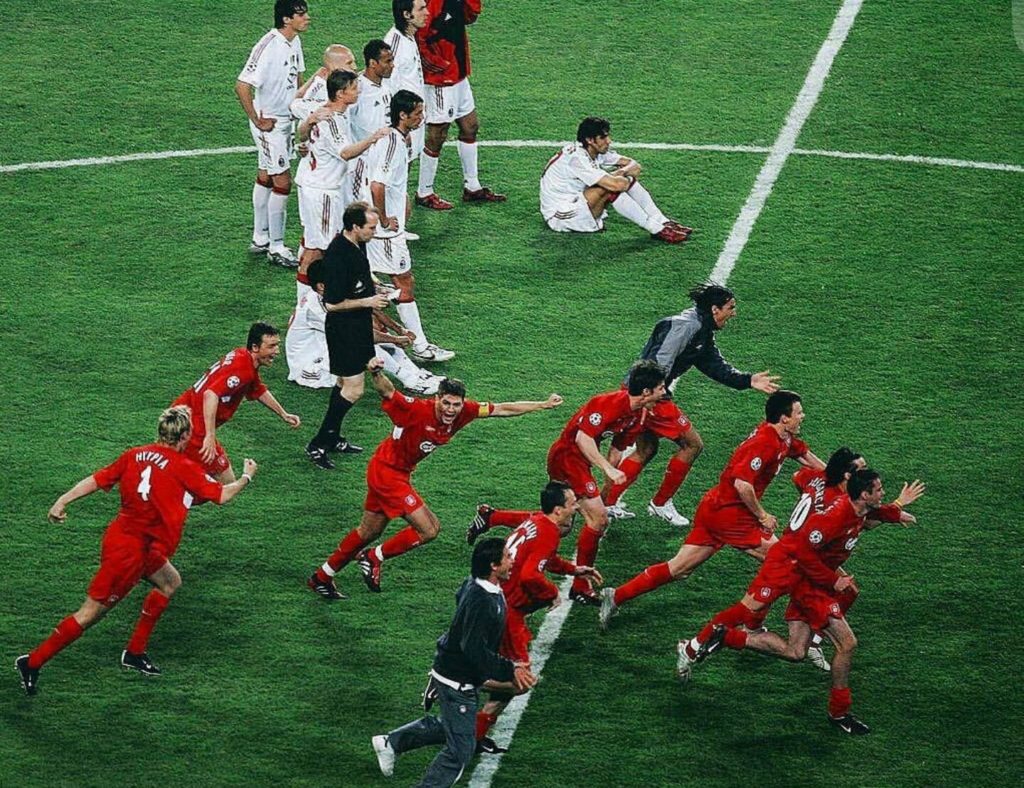
Milan eventually got revenge two years later in Athens. They defeated Liverpool to clinch their 7th and final European Cup. This time, they did not bottle it. But the painful memory of that fateful night in Istanbul still haunts every single Rossoneri faithful to date, despite all they have won and lost all these years.
*
The next few seasons were rather poor for Milan as they could not win a single Scudetto and failed to conquer Europe. But with new coach Massimiliano Allegri at the helm for the 2010-11 season, there was renewed optimism. Allegri engineered a squad overhaul as Zlatan Ibrahimovic, Thiago Silva and Alexandre Pato were brought in. Pato was electric during his brief spell in Milan. It is a pity that the Brazilian could not live up to the potential he displayed in the early days of his career. By the end of the season, Allegri had led the club to their 18th and final Scudetto so far.
*
Milan started their slow descent into the gloom in 2011. There were early signals. Though an outstanding team, the squad’s ageing core, including the likes of Inzaghi and Nesta, either departed or retired. Some star players left the club for greener pastures. I really don’t know what Milan was thinking about letting Pirlo go to Juventus. For FREE!
Modern football and Money. These two terms go hand in hand with each other. Russian oligarchs, American billionaires, and even certain countries own football clubs nowadays. These owners pumped outside cash into struggling clubs and have turned them into footballing superpowers. Milan fell prey to this trend as Paris St German, under new chairman Nasser Al-Khelaifi, splashed the cash. They broke Milan in half with defensive stalwart and main man in attack, Silva and Ibrahimovic departing to France. Failure seemed inevitable.
Allegri somehow managed to finish in a Champions League spot with a team that fielded Nigel De Jong, Mbaye Niang and Bojan Krkic in their starting lineup. However, the following season, the downward spiral gained momentum as Milan finished 8th in the league and, since then, has struggled with several managers being sacked over the years.
*
Milan has reeled in utter mediocrity for ten years. Countless managers were appointed. New owners took over. Club Legends came back. But nothing worked out. Around the same time, coincidentally or circumstantially, the blue half of Milan also slumped into mediocrity. It seemed like the dark days would continue till the end of time.
Troubling times lie ahead. A sickness has brought the world down to its knees. The Coronavirus has wreaked havoc all over. Football, too, suffered at its hands. Clubs have become insolvent, hundreds of staff members have become redundant, fans are barred entry, and the proposal of a breakaway money-grabbing Super League badly collapsed.
Amidst all this chaos, football in Milan has rediscovered its mojo. AC Milan, under Stephano Pioli, has a young, vibrant squad led by the ageless Zlatan Ibrahimovic, who seems to sparkle like fine wine. They were poised to win the Scudetto for a certain period but collapsed midway during the campaign. Regardless, they shall probably finish the season in a Champions League spot. On the other hand, Inter Milan has returned to the top of Italian football under Antonio Conte, finally breaking the Juventus monopoly in Serie A for good.
*
Since its global popularity during its heyday, Nokia failed as the big boys in town, while Apple and Samsung took over and drove the company into irrelevancy. In the 2010s, the company was at an all-time low—a colossal fall from grace for a once prestigious entity. The company was dead. However, Nokia is trying to find its feet again, restructuring itself and its products to suit the demands of the age. Can they once again become what they were previously? Well, it is improbable but certainly not impossible.
As long as there is hope.
Discover more from
Subscribe to get the latest posts sent to your email.
